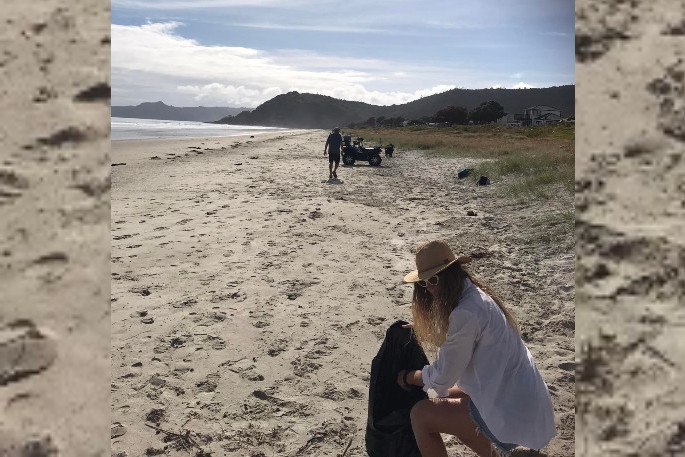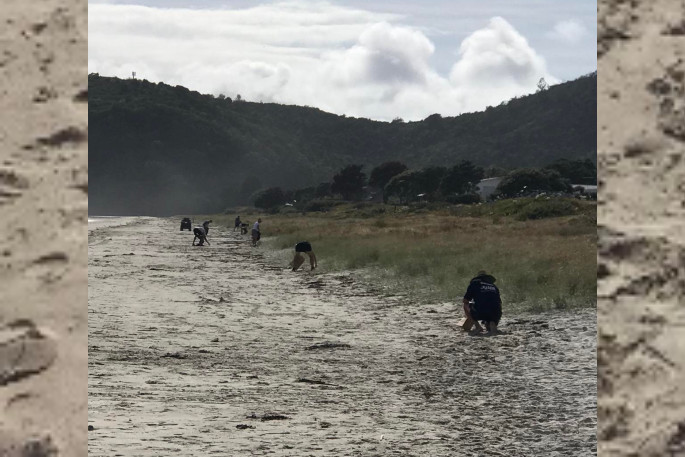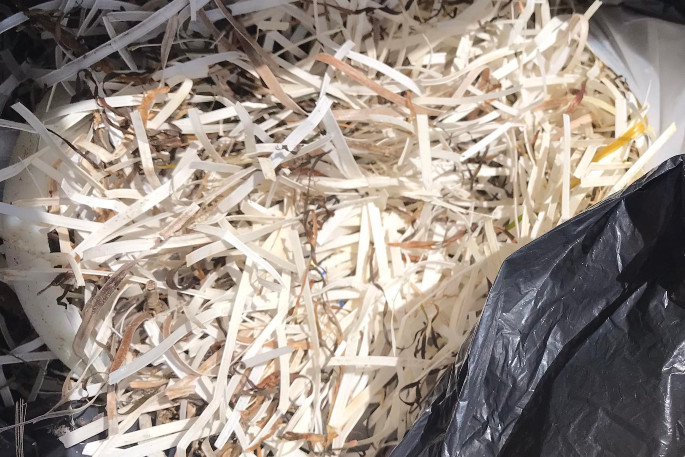Samples of the unusual plastic-like substance that has washed up on beaches along the Coromandel Peninsula have been sent to scientists for testing.
On Saturday, Matarangi Beach residents collected six bags of the white strips of what appeared to be shredded paper but felt like plastic, along a 100 metre stretch of their beach.
Today, Thames-Coromandel District Council Civil Defence controller Garry Towler says samples are being sent to the Waikato Regional Council for their scientist to confirm what it is.
'Fresh samples were gathered today and are being sent over to Hamilton. The results probably won't be back today. We should know by tomorrow.”
Matarangi Beach resident Peter Collins says he was made aware of the substance when a lady posted a picture on their local Facebook page on Thursday.
"The photo was of the woman holding of a handful of the stuff she had picked up off the Matarangi Beach," says Peter.
'She asked ‘what is this?' I went down to have a look and saw that it's the whole length of Matarangi Beach. Over one kilometre long."
 The unusual plastic-like substance that has been washing up on beaches along the Coromandel coast. Photo: Peter Collins.
The unusual plastic-like substance that has been washing up on beaches along the Coromandel coast. Photo: Peter Collins.
Wondering if it could be plastic Peter immediately tried contacting the local district and regional councils.
After feeling fobbed off and given the run-around, he decided to take matters into his own hands.
'If it is plastic it will wash off back to sea and harm our marine life and wild birdlife,” says Peter.
'The Waikato Regional Council Pollution said they didn't want to have to deal with it and don't have a budget and that I needed to contact the local council.”
Peter then contacted the Thames Coromandel District Council.
'They are arguing with WRC Pollution team still and not committing to anything. On Wednesday the beach was crystal clear. This happened after that king tide on Thursday. TCDC said contact Waikato Regional Council Pollution Team. WRC says it's a local litter issue.”
Still not knowing if it was plastic or not, and unable to engage anyone from the councils to come have a look and see if it was plastic, Peter felt something needed to be done.
'I've flame tested it. It melts and isn't breaking down, just brittle,” says Peter.
'Council determined via phone and recording that it was plastic litter.”
About 30 members of the community joined in to help him with a beach clean-up on Saturday meticulously picking out the white plastic-like material that was caught up in seaweed along the beach and washed up into the sand.
 Matarangi Beach residents helping to collect the white plastic-like substance from their beach on Saturday. Photo: Peter Collins.
Matarangi Beach residents helping to collect the white plastic-like substance from their beach on Saturday. Photo: Peter Collins.
On Sunday, Peter heard from others that the strange substance was also appearing on many other Coromandel beaches - Whangapoa Beach, Matarangi Beach, Rings Beach, Opito Beach, Kuaotunu Beach, and Otama Beach.
He asked people across Facebook to go check their beaches, and learned it was also at Waiheke Island and at St Lennard's Beach.
 Coromandel MP Scott Simpson at Matarangi Beach on Sunday recording his thoughts on video. Photo: Peter Collins.
Coromandel MP Scott Simpson at Matarangi Beach on Sunday recording his thoughts on video. Photo: Peter Collins.
On hearing about it on Sunday morning, Coromandel MP Scott Simpson drove over from Thames to take a look for himself.
'I brought some back with me to Thames,” says Simpson.
'Once its dried out its clear its organic, not plastic. But when it's wet it has the texture of plastic.
'When I first saw it on the beach on Sunday it looked and felt like plastic. I can absolutely understand why local people are concerned about it.
'It was on the foreshore environment and it didn't look like it was part of the foreshore environment. But when I took it away and it had dried – and I'm just a lay person – it looked organic.”
On Sunday evening, Thames-Coromandel District Council Emergency Management Unit sent out a message saying they had had confirmation from Waikato Regional Council that 'the shredded plastic looking substance, washing up on the East Coast is organic matter” and that it was dead seagrass.
Peter says he and other Matarangai residents were surprised that the council could determine that it was organic not plastic without seeing it for themselves.
There has been discussion from amongst the community about what the substance could be.
Ideas range from the king tide bringing ashore dead sea grass, or perhaps it's from artificial sea grass from sea mats placed in the Whangapoa harbour.
 Matarangi Beach residents helping to collect the white plastic-like substance from their beach on Saturday. Photo: Peter Collins.
Matarangi Beach residents helping to collect the white plastic-like substance from their beach on Saturday. Photo: Peter Collins.
'It's nothing anyone here has seen before,” says Peter. 'So many now are saying on Facebook that it's not organic. We need to know. If it's sea grass, has dredging killed it all? It's then an important part of the ecosystem.
'I called the unit, asked how they tested it,” says Peter.
'They were not sure, and said they told by Garry Towler that it's sea grass. They had no idea if it was tested."
Garry is the Thames-Coromandel District Council Emergency Management Unit Team Civil Defence Controller.
'I've told them that hundreds of volunteers have stood down due to the letter. They're getting back to me," says Peter.
Peter got in touch with a marine scientist at Otago University and sent samples by courier on Monday morning.
He has also sent samples to SunLive which will be sent on to marine scientists based in Tauranga.
He says that the locals are wondering whether to just keep collecting it until they get results back.
'I can't find any test places in Whitianga, even DOC can't help locally,” says Peter.
'It's going to be devastating if we wait for weeks or days and find out it is man-made.”
Simpson is very pleased he made the one hour trip over from Thames on Sunday to look for himself.
'It would have been really wrong to not go and have a look. Anything that could be an environmental disaster we need to know immediately.”
Waikato Regional Council Communications Team Leader Wendy Valois has told SunLive on Monday afternoon that the regional council will be examining the material, and that the regional council hadn't told anyone from the district council on Sunday that it was organic.
'Until they see it under the microscope our scientists won't determine what it is,” says Wendy.
'We have a number of scientists who will be looking at it when the sample arrives. They will be looking to determine under a microscope whether it is man-made or a naturally occurring substance.”
Wendy doesn't know how a communication sent out from Thames-Coromandel District Council on Sunday was able to have included in it that the Waikato Regional Council had confirmed that the material was organic when the regional council hadn't yet accessed it.
 The unusual plastic-like substance that has been washing up on beaches along the Coromandel coast. Photo: Peter Collins.
The unusual plastic-like substance that has been washing up on beaches along the Coromandel coast. Photo: Peter Collins.



0 comments
Leave a Comment
You must be logged in to make a comment.